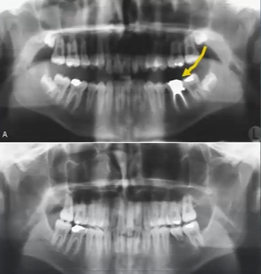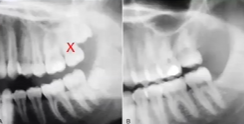Third Molars: Wisdom of Wisdom Teeth
1/7
There's no tags or description
Looks like no tags are added yet.
Name | Mastery | Learn | Test | Matching | Spaced |
|---|
No study sessions yet.
8 Terms
__ _____ third molars are extracted from approximately __ ____ people in the U.S. each year at an approximate annual cost of over __ ____
Formation of third molars begins at dental age __
Crown formation is completed at age __
10 Million third molars are extracted from approximately 5 million people in the U.S. each year at an approximate annual cost of over 3 billion
Formation of third molars begins at dental age 12
Crown formation is completed at age 15
Can 3rd Molars be useful?
Auto transplantation to replace missing teeth

Shift into position of missing 2nd molar

Mythology of Third Molars
Impacted third Molars Have high incidence of pathology
Incidence is only 12%, which is compared to appendicitis at 10%, is not high enough to justify surgical intervention
Early removal is less traumatic
Early removal of asymptomatic impacted molars is more traumatic than leaving them
Pain, swelling, bruising, malaise, dry socket, secondary infection, paresthesia
Pressure of erupting third molars causes crowding of anterior teeth
Association, not causation
The risk of pathology in impacted third molars increases with age
Only 0.81% experienced cystic formation for 23 years
There is little risk or harm in the removal of third molars
Pain, swelling, bruising, malaise, dry socket, secondary infection, paresthesia, fracture, neuralgia
T/F The practice of prophylactic removal of pathology-free impacted third molars should be discontinued as there is no evidence to support a health benefit to patients from the prophylactic removal of pathology-free impacted teeth
T
What are reasons for third molar impaction, rank from highest to lowest impacts
Vertical direction of condylar growth
Reduced mandible length
Backward-directed eruption of the mandibular dentition
Retarded maturation of third molars
What are good indicators that tell you third molars will be impacted?
Long ascending ramus
Short mandibular length
Greater mesial crown inclinations of third molars
Prediction of space available
Cephalometric predictors at 8-9: insufficiently reliable, only works 58% of the time
Inclination of third molar at pre- adolescence: no predictive value
Consensus
Little rationale for extraction solely to minimize crowding
Orthodontic therapy with posterior movement can result in impaction of third molars
Third molars are not needed for basal skeletal components
Post-op pain, swelling, infection can be minimized by removing third molars in young pt when roots are only 2/3 developed
Enucleation of 3rd molar buds based on measurements obtained age 7-9 is not acceptable